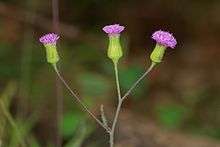Emilia sonchifolia
| Emilia sonchifolia | |
|---|---|
 | |
| Scientific classification | |
| Kingdom: | Plantae |
| (unranked): | Angiosperms |
| (unranked): | Eudicots |
| (unranked): | Asterids |
| Order: | Asterales |
| Family: | Asteraceae |
| Genus: | Emilia |
| Species: | E. sonchifolia |
| Binomial name | |
| Emilia sonchifolia (L.) DC. ex Wight | |
| Synonyms[1][2] | |
|
List
| |
Emilia sonchifolia, also known as lilac tasselflower or cupid's shaving brush is tropical flowering species of tasselflower and in the sunflower family.[3] It is widespread in tropical regions around the world, apparently native to Asia (China, India, Southeast Asia, etc.) and naturalized in Africa, Australia, the Americas, and various oceanic islands.[4][5][6][7][8][9][10][11]
Emilia sonchifolia is a branching, perennial herb up to 40 cm (15.5 in) tall. Leaves are lyrate-pinnatilobed, up to 10 cm (4 in) long, sometimes becoming purplish as they get old. One plant can produce several pink or purplish flower heads.[4]
Medicinal uses
It is a medicinal herb in Chinese, called ye xia hong (Chinese: 葉下紅). It is one among the "Ten Sacred Flowers of Kerala State in India, collectively known as Dasapushpam. In Vietnam, is has been used in traditional medicine for the treatment of fever, sore throat, diarrhea, eczema and as an antidote for snake bites.[12]
Toxicity
Emilia sonchifolia contains tumorigenic pyrrolizidine alkaloids.[13]
Gallery
_in_Hyderabad%2C_AP_W_IMG_0421.jpg) in Hyderabad, India.
in Hyderabad, India._in_Hyderabad%2C_AP_W_IMG_0416.jpg) in Hyderabad, India.
in Hyderabad, India.
References
- ↑ "Emilia sonchifolia record n° 95932". African Plants Database. South African National Biodiversity Institute, the Conservatoire et Jardin botaniques de la Ville de Genève and Tela Botanica. Retrieved 2008-05-21.
- ↑ "The Plant List: A Working List of All Plant Species".
- ↑ Natural Resources Conservation Service (NRCS). "PLANTS Profile, Emilia sonchifolia". The PLANTS Database. United States Department of Agriculture. Retrieved 2008-05-21.
- 1 2 Flora of China, 一点红 yi dian hong, Emilia sonchifolia (Linnaeus) Candolle
- ↑ Atlas of Living Australia
- ↑ Biota of North America Program 2014 county distribution map
- ↑ Nicolson, D. H. 1980. Summary of cytological information on Emilia and the taxonomy of four Pacific taxa of Emilia (Asteraceae: Senecioneae). Systematic Botany 5(4): 391–407
- ↑ Nelson, C. H. 2008. Catálogo de las Plantas Vasculares de Honduras 1–1576. Secretaria de Recursos Naturales y Ambiente, Tegucigalpa
- ↑ Berendsohn, W.G. & A.E. Araniva de González. 1989. Listado básico de la Flora Salvadorensis: Dicotyledonae, Sympetalae (pro parte): Labiatae, Bignoniaceae, Acanthaceae, Pedaliaceae, Martyniaceae, Gesneriaceae, Compositae. Cuscatlania 1(3): 290–1–290–13
- ↑ Humbert, H. 1963. Composées. Flore de Madagascar et des Comores 189: 623–911
- ↑ Jeffrey, C. 1986. Notes on Compositae: IV. The Senecioneae in East Tropical Africa. Kew Bulletin 41(4): 873–943
- ↑ Tanaka, Yoshitaka; Van Ke, Nguyen (2007). Edible Wild Plants of Vietnam: The Bountiful Garden. Thailand: Orchid Press. p. 43. ISBN 9745240893.
- ↑ Fu, P.P., Yang, Y.C., Xia, Q., Chou, M.C., Cui, Y.Y., Lin G., "Pyrrolizidine alkaloids-tumorigenic components in Chinese herbal medicines and dietary supplements", Journal of Food and Drug Analysis, Vol. 10, No. 4, 2002, pp. 198-211
External links
![]() Media related to Emilia sonchifolia at Wikimedia Commons
Media related to Emilia sonchifolia at Wikimedia Commons
![]() Data related to Emilia sonchifolia at Wikispecies
Data related to Emilia sonchifolia at Wikispecies